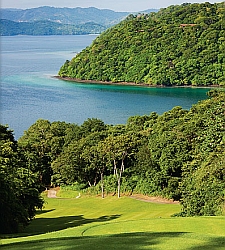As more and more Americans have discovered, the Arnold Palmer-designed golf course at the Four Seasons Resort Papagayo Peninsula, offering stunning elevated ocean views along the Northwest Pacific Coast of Costa Rica, is paradise in the middle of nowhere.
Definitely one of the most luxurious resorts in all of Costa Rica, it is located on the tip of the Papagayo Peninsula, a promontory so narrow that the hotel has sandy beaches on both sides. You take a right turn pass the Rio Tempisque Rio Bridge off the highway leading from the Daniel Oduber International Airport, and drive 15 minutes to get to the entrance and another 15 minutes to the hotel, seeing the golf course on the way.
The Palmer design team took full advantage of the piece of land they were given with the ocean views and natural elevation changes to create some unforgettable holes, but ones that resort golfers can still find playable, yet challenging from the proper sets of tees.
Your experience begins atop one of Peninsula Papagayo’s highest plateaus, overlooking Bahía de Culebra. Spectacular water views await you at 14 of the 18 holes. The tee box on No. 3 is situated at the top of a cliff with a 360-degree view of the ocean. The signature hole, No. 6, El Bajo, features a dramatic 446-yard par-4 with a tee shot that plays 200 feet downhill to a receptive valley-shaped fairway. The green is perched out on a cliff with the ocean behind it. There is a good variety of holes, including some shorter, but tricky par 4s on the back nine, which culminates on the scenic par 5 18th with a green protected by a water hazard, offering views of the Pacific Ocean and Bahía de Culebra.
The course has already been ranked as high as No. 52 in Golf Digest’s Top 100 Courses Outside the United States. It dropped to No. 70 in the most recent update, but the only explanation is that not enough of the magazine’s raters, include me in that number, got a chance to see it before voting.
Landy Blank of Costa Rica Golf Adventures, who has played all over the world, definitely feels the course deserves to be included in such world rankings. “The vistas are spectacular and are equal to any that you will experience at Kauri Cliffs (New Zealand) or Pebble Beach,” he said. “The elevation changes and changing wind conditions make each round a new experience. It is similar to Pacific Dunes in that when the wind is quiet the course is manageable, but when the wind picks up even the best players will have their hands full.”
Playing from the whites at 6,147 yards on a recent visit, I found that I could still compete on an almost an even playing field with director of golf Randoll Viquez, my former assistant when I was at Playa Conchal, when he went back to the tips at 6,780 yards. I could see why Viquez qualified as one of the long drivers in Latin America for many years. Better yet, it seemed he had improved his wedge game to control distance better as he had several tap ins for birdies.
“It’s definitely one of the most beautiful courses I’ve ever played,” Viquez noted. “I hear it similar comments from our guests.” I heard other golfers repeat this back at the hotel, too. Having played many of the top 100 in the world, I would agree.
The course is a Certified Audubon Cooperative Sanctuary, given for its efforts to preserve and enhance wildlife habitat and natural resources. The course, set amid crystalline waters and deep green forests (they turn brown in the dry season), has labelled important trees, turning the cart paths into a botanical garden. You get the chance to see and appreciate a diversity of colorful plant, tree, bird and animal species as you drive from hole to hole. Walking is really not an option. Viquez pointed out some congo (howler) monkeys up in the tees on one hole, and capuchin (white-faced) monkeys are also seen at times. The “jungle rule” on the scorecard says, “Please respect our wildlife and do not enter jungle, playing it as lateral hazard and taking one-stroke penalty.”
The green fees are pricey at $185 (9 holes and twilight) to $230, but Viquez reported the course is no longer limited to guests of the hotel as it used to be. He expects additional guests to come from the other resorts in the Papagayo Peninsula area, part of a government-sponsored development program modeled after Cancun in Mexico and Punta Cana in the Dominican Republic.
Local Costa Rica architect Ronald Zurcher drew his inspiration for the design of the hotel from the area’s cultural history and surrounding environment. Guest rooms suggest tree houses. There are two expansive beaches, Playa Blanca and Viador Beach, offering an enticing array of water sports. Room rates range from $400 and up per night.
“Pura Vida” translates to the good life for Costa Ricans and it holds true for visitors at the Four Seasons.

